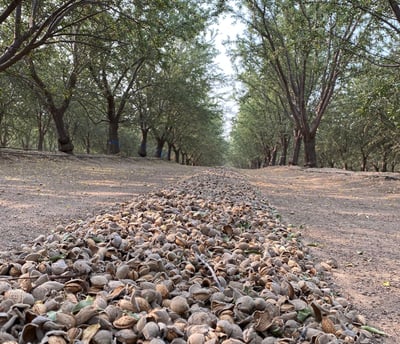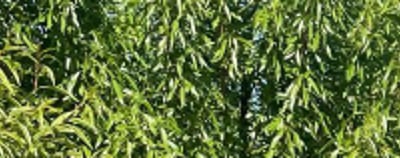Almond Postharvest: Nutrient and Irrigation Management


Almond harvest season is just beginning. Also during this period, almond trees continue building the pieces that will become the next year’s crop. For almonds, flower bud differentiation takes place during late summer – beginning mid- to late-August and continues through early September. This means that next year's bloom and subsequent crop is being formed in the middle of this year's harvest. In fact, factors influencing next year’s almond bloom intensity initiate months prior to bloom. Consequently, the physiological and pathological stresses exerted on almond trees in the current season, especially during bud differentiation, will influence bloom and subsequent yield in the next year. Not surprisingly, nutrient and irrigation management practices during this period being the major factors.
Postharvest Tree Nutrition
A number of postharvest nutrient inputs such as boron (B), potassium (K), and zinc (Zn) when needed, are proven to deliver increased yield in the next season. On the other hand, nitrogen (N), when applied in fall does not improve yield in well managed orchards. Therefore, knowing effective delivery for each nutrient is key to the health and performance of your orchard.
Potassium demand by almonds trees is very high. Inadequate K levels will affect tree yield by increasing spur death and the percent of spurs that had flowers, and therefore set nuts. Potassium deficient almond trees show leaf symptoms in the spring if the deficiency is severe and by early summer even milder deficiencies can produce symptoms on high yielding trees. Postharvest fertilization should be based on using the soil as a “K bank” for the following year. Banding or applications concentrated in the micro-irrigation zones deliver more effective results than broadcast in orchards. In very sandy soils with low cation exchange capacity (CEC), lower application rates of dry K fertilizer in the fall are recommended compared to soils with more clay and higher CECs. This will avoid the expensive loss of leaching K due to excessive winter rain or irrigation water. When summer leaf K levels show the orchard is deficient, yield will suffer the following year even if you fertilize in the fall so do not get behind in your K fertility program.
Boron is a key micronutrient for fruit set. In fact, B deficiency can compromise fruit set even if vegetative symptoms are absent. To determine deficiency, a hull analysis should be taken to determine tree B status. Yield can be reduced when B hull concentrations are below 80 ppm. A fall B spray can significantly increase yield when hull B analysis show low to adequate orchard B (80-100 ppm). Applications of B through irrigation are effective if timed to coincide with bud maturation (August–October). However, foliar pre-bloom, early post bloom and post fruit maturity applications are most effective and any high quality, soluble boron source can be used. It is important to note that groundwater usually contains B and should always be considered in all fertilization plans. Boron toxicity can easily result from over application.
In almonds, the most critical role for Zn is in bud formation, development and opening, and stem extension. Even a transient or incipient deficiency, needs to be corrected quickly. Soil applications through fertigation can be helpful, but efficacy will be highly dependent on soil pH and soil fixation. Zinc foliar treatment is often the most effective Zn fertilization method. Early fall foliar application may be effective if trees are deficient. The longer the tree’s nutrient status remains at the low end or below the optimal range at key stages of tree phenology, the greater the negative effects on yield, fruit quality and next year’s bloom. Spraying Zn early in spring at 1/2- to 2/3-leaf expansion is recommended. During the leaf expansion period leaves have a cuticle thin enough for nutrient uptake and sufficient surface area that the amount of nutrient taken up is large enough to enhance tree performance.
Nitrogen is the most important mineral nutrient in almond production. Mature almond trees use 90% of their total annual N requirement to supply the developing fruit and kernel. This occurs between fruit-set and hull-split with the remainder taken up soon after harvest. If in July your leaf nitrogen value is higher than 2.5%, a fall nitrogen application is likely not recommended. However, if you determine that nitrogen application is needed, injecting N through in-season drip irrigation is the most effective way to make nitrogen immediately available in the most active root zone of the tree. Foliar applications can also be used to provide supplemental N to trees and can be applied in a targeted manner to trees with greater demand or to address isolated N deficiencies. If tree health is suboptimal after harvest (due to dry down, salinity, shaker damage), N application is not recommended since trees will have critically reduced nitrogen uptake.
Mismanaging nutrient and water in the postharvest period will influence yield in the next year.


Irrigation Management
Water management is also extremely important as extreme water stress in the postharvest period – mid-August through early November – has been shown to reduce next year’s yield. In August alone almond trees can demand an estimated 6.5-7″ of water based on location and weather. Almond trees have their highest water usage during July and August, when the days are long and hotter. In fact, research has shown that the first 8″ of water applied during the postharvest period – August and September – is the most critical water applied to maintain orchard yields in the following season.
As mentioned before, flower bud differentiation in almonds takes place during late summer so water shortages during this time significantly reduces carbohydrate synthesis affecting next year’s bloom. Therefore, after harvest, water should be applied as soon as possible to alleviate stress. Postharvest irrigation maximizes the production and storage of key nutrients and carbohydrates the almond tree will ultimately need to bloom, develop leaves and set fruit in the spring. After the initial postharvest irrigation, soil moisture sensors can be used to adjust future irrigation events.
In summary, plan to reduce tree stress as much as possible during the harvest period. Make sure that shaking and pickup are done in a timely manner to minimize the period the trees are under water stress. Irrigate the trees as soon as possible after harvest is complete.
Excess nitrogen application will stimulate vegetative growth and negatively impact yield.
